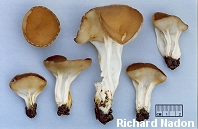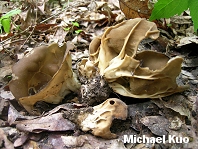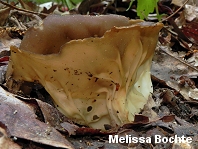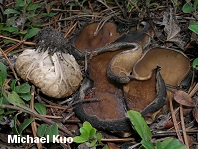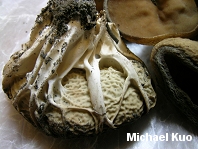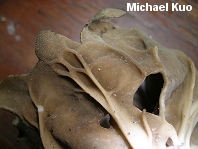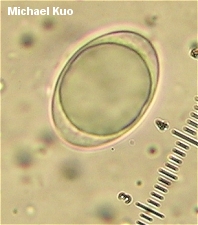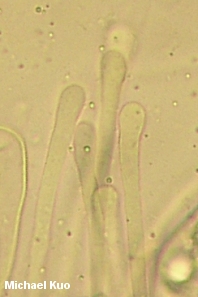| Major Groups > Cup Fungi > Helvella acetabulum |

|
Helvella acetabulum [ Ascomycetes > Pezizales > Helvellaceae > Helvella . . . ] by Michael Kuo Here is a funky species of Helvella, reminiscent of a chalice or grail with an ornate base. The spores are produced on the upper surface of the cup, which is smooth and yellow-brown, and the structure is held aloft by a beautifully ribbed and pocketed stem. Crucial for identification is the distinctive way in which the ribs extend onto the undersurface of the cup, sometimes nearly to the margin. In most areas of North America Helvella acetabulum is a late spring and early summer species--but in the Rocky Mountains it is sometimes found in late summer, and it can appear over winter in warm climates. Paxina acetabulum is a former name. Helvella costifera is a similar species; it features a gray to grayish brown cap that lacks yellow tones, and its stem usually features blunt-edged, rather than sharp-edged, ribs. Helvella griseoalba, described by Nancy Weber (1972), has been synonymized with Helvella costifera by Abbot & Currah (1997). Helvella leucomelaena and Helvella queletii are superficially similar, but the former has a less developed stem that is often buried underground, and the latter has a strongly inrolled cap margin. The ribs do not extend onto the cap's undersurface in either species. Description: Ecology: Probably mycorrhizal; growing alone or gregariously, under hardwoods or conifers, often in the vicinity of stumps or decaying wood; spring and early summer--or late summer in the Rocky Mountains, or winter and spring in coastal California; widely distributed in North America. Cap: 2-12 cm across; cup-shaped, sometimes becoming more or less flat in age; upper surface yellow-brown to brown, bald, and smooth; undersurface brown to yellow-brown, sometimes paler near the stem, finely fuzzy near the margin, with forked whitish to brownish ribs that extend from the stem, sometimes almost to the margin. Flesh: Thin; brittle; brownish; whitish and chambered in the stem. Stem: 2-9 cm long; up to 5 cm thick; becoming broader near the cap; deeply pocketed and ribbed with sharp-edged (occasionally blunt) forking ribs that extend onto the undersurface of the cap; whitish to brownish; finely hairy. Odor and Taste: Not distinctive. Chemical Reactions: KOH negative on all surfaces and flesh. Microscopic Features: Spores 16-20 x 11-14 µ; elliptical; smooth; with one central oil droplet. Asci 8-spored. Paraphyses cylindric with clavate or merely rounded apices; 4-6 µ wide; hyaline to brownish. REFERENCES: (Linnaeus, 1753) Quélet, 1874. (Fries, 1822; Smith Weber, 1972; Smith, Smith & Weber, 1981; Arora, 1986; States, 1990; Phillips, 1991/2005; Lincoff, 1992; Metzler & Metzler, 1992; Abbot & Currah, 1997; McNeil, 2006; Miller & Miller, 2006.) Herb. Kuo 03110702, 04211204, 08231201. This site contains no information about the edibility or toxicity of mushrooms. |
© MushroomExpert.Com |
|
Cite this page as: Kuo, M. (2012, August). Helvella acetabulum. Retrieved from the MushroomExpert.Com Web site: http://www.mushroomexpert.com/helvella_acetabulum.html |
